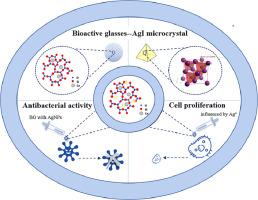Journal of Non-Crystalline Solids ( IF 3.2 ) Pub Date : 2020-07-16 , DOI: 10.1016/j.jnoncrysol.2020.120293 A. Feraru , Zs.R. Tóth , K. Magyari , Zs. Pap , M. Todea , M. Mureșan-Pop , D.C. Vodnar , E. Licarete , K. Hernadi , L. Baia

|
AgI microcrystals are used as Ag nanoparticles’ source to avoid the transformation of silver into AgCl, whose presence can affect the materials’ biocompatibility. The AgI microcrystals are obtain by using solvothermal crystallization and then they are embedded into bioactive glass matrices using a sol-gel method. The influence of AgI concentration on the structural, morphological, bioactive and biocompatible properties of the composites is carefully analyzed. By using the above-mentioned approach, all the obtained samples are AgCl free. Furthermore, the sample with 0.1 mol% AgI shows the signature of mobile I− and Ag° metallic species that negatively affect the in vitro bioactivity. It is also demonstrated that the presence of Ag° metallic species restrained the keratinocytes cells viability. The composites with AgNPs and Ag2O species exhibited excellent bioactivity and good cell proliferation rate. A moderate antibacterial effect against Pseudomonas aeruginosa was also evidenced in the case of the composites with AgNPs content.
中文翻译:

基于硅酸盐生物活性玻璃和碘化银微晶的复合材料,用于组织工程应用
AgI微晶被用作Ag纳米颗粒的来源,以避免银转化为AgCl,Ag的存在会影响材料的生物相容性。通过溶剂热结晶获得AgI微晶,然后使用溶胶-凝胶法将其包埋入生物活性玻璃基质中。仔细分析了AgI浓度对复合材料的结构,形态,生物活性和生物相容性的影响。通过使用上述方法,所有获得的样品都不含AgCl。此外,用0.1%(摩尔)碘化银示出了示例移动我的签名-和Ag°,所述负面影响金属物质在体外的生物活性。还证明了Ag°金属物种的存在抑制了角质形成细胞的生存能力。具有AgNPs和Ag 2 O的复合材料表现出优异的生物活性和良好的细胞增殖速率。在具有AgNPs含量的复合物的情况下,也证明了对铜绿假单胞菌的中等抗菌作用。











































 京公网安备 11010802027423号
京公网安备 11010802027423号